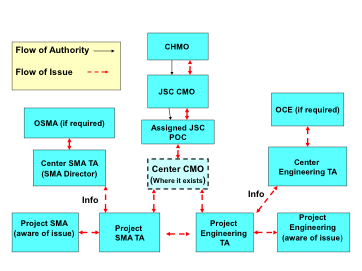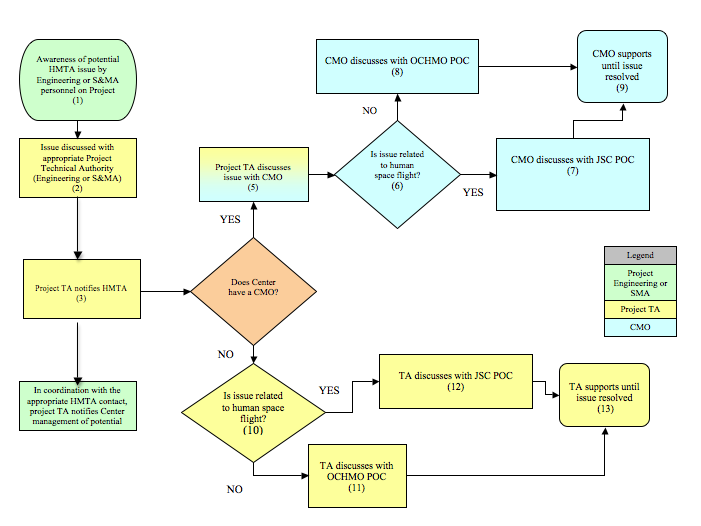Appendix D. Health and Medical Technical Authority Implementation Process Description
(Based on the Letter of Agreement between the Office of the Chief Health and Medical Officer (CHMO), the Office of the Chief Engineer (OCE), and the Office of Safety and Mission Assurance (OSMA), "Collaboration for Health and Medical Technical Authority (HMTA) Implementation," signed June 14, 2010.)
D.1 Health and Medical Technical Authority Awareness
D.1.1 At the program/project level, engineering and SMA TA work is enabled by the contributions of the program/project working-level engineers and SMA personnel with support from the Center engineering/SMA infrastructure. The engineering and SMA TAs are also represented on the program/project internal control boards, change boards, and review boards (or their equivalents). Therefore, engineering and SMA program/project TAs have a timely awareness of issues that could potentially impact health and medical policy, procedural requirements, or technical standards and require HMTA participation in their resolution.
D.1.2 Unlike engineering and SMA, HMTA is not integrated at the working level in the
day-to-day program/project processes except for JSC. To enhance HMTA awareness at all Centers, the CHMO will utilize the participation of engineering and SMA TAs in the day-to-day program/project work as the HMTA awareness "eyes and ears." Their responsibility is to identify potential health, medical, and human performance issues and notify the appropriate levels of HMTA in a timely manner (see paragraph 2.6 of this NPR).
D.1.3 To ensure HMTA awareness at the Centers, the OCHMO will provide HMTA awareness training for use by the appropriate engineering and SMA personnel at each Center. The training will include identification of health and medical policy, procedural requirements, technical standards, and the HMTA problem reporting and resolution process established by this NPR. The HMTA training will be incorporated into existing engineering and SMA training by the OCE and OSMA.
D.2 Health and Medical Technical Authority Problem Reporting and Resolution Flow Paths
D.2.1 In implementing HMTA at each Center other than JSC, two distinct flow paths for problem reporting and resolution are established - one for human space flight, which flows through a JSC POC (Figure D-1) and one for all other issues (including R&T when appropriate) which flows through an OCHMO POC (Figure D-2). Additionally, the HMTA process flow path is dependent on whether or not the Center has an assigned CMO. The JSC CMO will designate a JSC HMTA POC for human space flight issues (paragraph 3.1.2.2), and the CHMO will designate an OCHMO HMTA POC for non-human space flight issues (paragraph 2.1.h).

Figure D-1- Human Space Flight Health and Medical Technical Authority
Awareness Flow Paths

Figure D-2- Other Health and Medical Technical Authority
Awareness Flow Paths (including R&T)
D.2.1.1 At Centers with a CMO, the program/project engineering and SMA TAs will notify the CMO of the potential HMTA issue and support the resolution of the issue as required. The CMO will be the Center's primary interface with JSC for coordinating resolution of potential human space flight HMTA issues and the OCHMO POC for non-human space flight issues. For Centers without a CMO, the program/project engineering/SMA TA will be the Center's primary interface with JSC for coordinating resolution of potential human space flight HMTA issues and the OCHMO POC for non-human space flight issues. The appropriate Center engineering TA or SMA TA is responsible for discussion with the Agency's OCE or OSMA, if required.
D.3 Summary of HMTA Problem Reporting and Resolution Flow Paths
(Note: paragraph numbers correspond to Figure D-3, HMTA Process Flow Chart)
1. Engineering or SMA personnel working on a program/project become aware of an issue that potentially can impact health and medical policy, procedural requirement, or technical standard.
2. The person identifying the potential issue notifies the engineering or SMA TA assigned to the program/project.
3. The program/project engineering or SMA TA notifies the appropriate HMTA to assist in the resolution.
4. The program/project engineering or SMA TA will notify their Center management of potential HMTA issues.
For Centers with a CMO
5. If a CMO is assigned to the Center, the program/project engineering or SMA TA notifies and discusses the potential issue with the CMO.
6. The CMO decides if the potential issue is related to human space flight.
7. If related, the CMO discusses the potential issue with the POC from JSC (JSC has been delegated HMTA from the OCHMO for human space flight). The JSC POC will identify the appropriate HMTA technical expert(s) to resolve the issue.
8. If unrelated to human space flight, the CMO discusses the potential issue with the POC from the OCHMO. The OCHMO POC will identify the appropriate HMTA technical expert(s) to resolve the issue.
9. The CMO supports the resolution of the issue (e.g., providing program/project or Center POCs, providing additional data if needed, etc.).
For Centers without a CMO
10. The engineering or SMA TA decides if the potential issue is related to human space flight.
11. If related, the program/project engineering or SMA TA discusses the potential issue with the POC from JSC (JSC has been delegated HMTA by the OCHMO for human space flight). The JSC POC will identify the appropriate HMTA technical expert(s) to resolve the issue.
12. If unrelated to human space flight, the program/project engineering or SMA TA discusses the potential issue with the POC from the OCHMO. The OCHMO POC will identify the appropriate HMTA technical expert(s) to resolve the issue.
13. The HMTA POC will confer with the program/project engineering or SMA TA if additional information or clarification is needed regarding the identified issue (e.g., providing additional program/project or Center POCs, providing additional data if needed, etc.).
Figure D-3 HMTA Process Flow Chart

DISTRIBUTION:
NODIS
This Document is Obsolete and Is No Longer Used.
Check the NODIS Library to access the current version:
http://nodis3.gsfc.nasa.gov
![[NASA Logo]](../Images/nasaball.gif)


